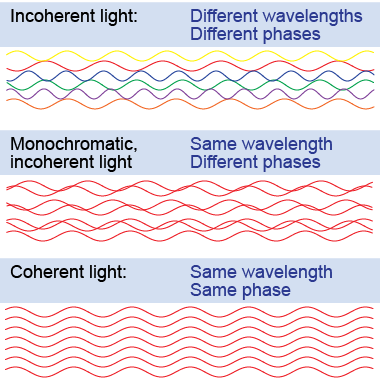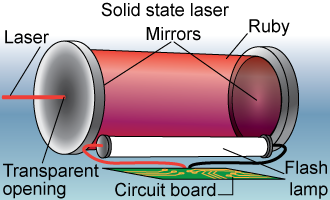|
 The laser uses stimulated emission to produce coherent light. Ordinary white light from a light bulb is incoherent: It consists of light of many different wavelengths and many different phases. When white light is passed through a filter (or colored glass), it becomes monochromatic light, because it consists of only one color of light (such as red). This monochromatic light is still incoherent, however, because it may have many different phases. The problem with incoherent light, even if it is monochromatic, is that the waves can add both constructively and destructively. The laser produces monochromatic light that is also in phase—which is called coherent light. The main advantage of coherent light is that the light waves add constructively, so that a laser beam can have a very high intensity (even if the beam is narrow). The high intensity of laser light is why you should never look directly at a laser.
The laser uses stimulated emission to produce coherent light. Ordinary white light from a light bulb is incoherent: It consists of light of many different wavelengths and many different phases. When white light is passed through a filter (or colored glass), it becomes monochromatic light, because it consists of only one color of light (such as red). This monochromatic light is still incoherent, however, because it may have many different phases. The problem with incoherent light, even if it is monochromatic, is that the waves can add both constructively and destructively. The laser produces monochromatic light that is also in phase—which is called coherent light. The main advantage of coherent light is that the light waves add constructively, so that a laser beam can have a very high intensity (even if the beam is narrow). The high intensity of laser light is why you should never look directly at a laser. 
|
To design a laser, ask the following questions: What is the desired energy of the laser light? (For example, do we want a red or a blue laser?) What is the power required? The answer to the first question determines the type of material that can be used in the laser. The atoms that release the laser light are contained in this material. The answer to the last question determines the geometry of the device and the energy source that we use to power it. For example, a laser pointer device can be powered by a small battery but a metal cutting laser must be powered by a large power supply. 
|
 Constructing a laser requires three components:
Constructing a laser requires three components: - a substance that contains atoms whose electrons can be excited (or energized) to the desired energy levels;
- two parallel mirrors, one with perfect reflection and one that allows a small fraction of light to go through; and
- an energy source that will be used to excite the electrons to the desired energy levels.
The atoms are located between two parallel mirror surfaces that reflect the emitted photons back and forth. One of these mirrors allows a small fraction—about 1%—of the photons to pass through it. These escaping photons form the laser beam. The atoms are excited by some energy source such as a strong light source or a voltage. 
|
Can light of different wavelengths ever be in phase?
 |
No. Because the light has different wavelengths, it also has different frequencies. Therefore, even if all the light starts with a crest at the same point, it will soon go out of phase. A similar phenomenon can be seen with beats in sound. 
|
| |
|

